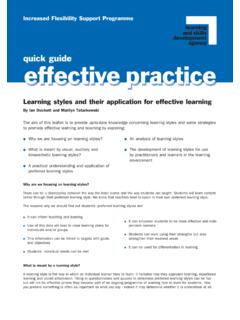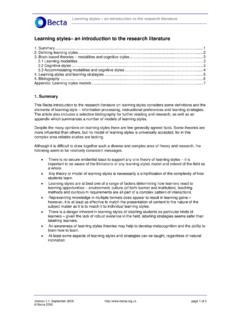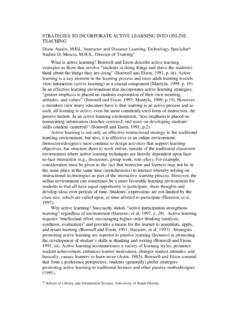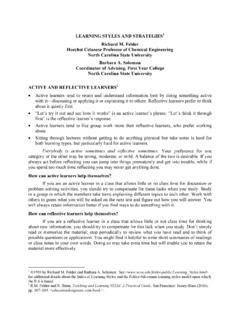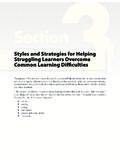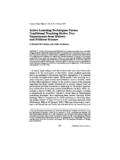Transcription of Understanding Your Learning Styles - LD Pride
1 Understanding Your Learning Styles by Copyright 2008. 1. An Introduction to Understanding Learning Styles Introduction Have you ever wondered why you perform better under the tutelage of one instructor versus another in the exact same subject? The answer very well could lie in the way the instructor presents the information and the type of Learning style that best meets your needs. Everyone has a different Learning style and learns better through different means. Understanding your particular Learning style and how to best meet the needs of that Learning style is essential to performing better in the classroom. Once you have unlocked your Learning style and discovered the best methods for helping you to learn through that style, you my be surprised to discover just how well you can flourish in the classroom, even in subjects that you previously found difficult.
2 What are Learning Styles ? Before we delve into how to best benefit from identifying your Learning style, we need to spend a few moments studying the different types of Learning Styles and how to best identify which Learning style category you fit into. Learning Styles refer to the variations in your ability to accumulate as well as assimilate information. Basically, your Learning style is the method that best allows you to gather and use knowledge in a specific manner. Most experts agree that there are three basic Learning Styles . Each individual may possess a single style or could possess a combination of different Learning Styles . In most cases, the characteristics of a Learning style can even be observed at a relatively young age. 2. Once you have identified your particular Learning style you will be able to identify ways in which you can adapt the Learning process and your studies to maximize your education.
3 Visual Learners Individuals who fall into this category typically learn through what they are able to see with their own eyes. Visual learners are those students who jockey for the positions at the front of the class, must have front row theater seats and love to be right up front for sporting events in order to obtain the best view. Visual learners have a tendency to describe everything that they see in terms of appearances. These learners love visual aids such as photos, diagrams, maps and graphs. Visual learners frequently are good writers and will commonly perform quite well on written assignments. Auditory Learners Auditory learners are very good listeners. They tend to absorb information in a more efficient manner through sounds, music, discussions, teachings, etc. These individuals will be more likely to record lectures so that they can replay them at a later time for study purposes.
4 Auditory learners appreciate books on tape and may find that reading aloud will help them to retain information. Rather than written reports, auditory learners tend to do better on oral presentations and reports. 3. Kinesthetic Learners Kinesthetic learners are tactile Learning . This means that they learn best through moving, doing, acting out and touching. Projects that are hands-on in nature are best for kinesthetic learners. Kinesthetic learners tend to become frustrated when they must sit for long periods of time. They enjoy conducting experiments, exploring and performing tasks. Vis ual 65%. Auditory 30%. Tactile 5%. Identify your Learning Style Based on the information just presented, are you able to determine which Learning style category you fall into? Sometimes it is quite easy to determine and you may have already had an idea that you might have a particular Learning style.
5 In other cases, it may not be quite so easy to identify. This is commonly the case if you possess characteristics from more than one Learning style. Below is a quiz that can help to guide you through the process of identifying your specific Learning style. 4. Benefits of Understanding your Learning Style It is important to keep in mind that you as an individual are a unique learner. No two people are exactly the same and no two people learn in exactly the same manner. There are many advantages to Understanding the way in which you are able to process information most efficiently. Some of these benefits include: Academic Advantages Maximizing your Learning potential Succeed on all educational levels Understand how to best study and score better on exams and tests Overcome limitations in the classroom Reduces frustration and stress levels Expand your existing Learning strategies Personal Advantages Improve your self-confidence and self-esteem Learn how to best use your brain Gain insight into your own strengths as well as weaknesses Learn how to enjoy Learning more Develop a motivation for Learning How to maximize your natural abilities and skills 5.
6 Professional Advantages Stay up to date on professional topics Gain an edge over the competition Manage teams in a more effective manner Learn how to deliver more effective presentations Improve your sales skills Increasing your earning power Keep in mind that there is really no right or even no wrong way to learn. Everyone is unique and each Learning style offers advantages as well as disadvantages. Understanding your own Learning style can help you to learn as well as work in a more efficient manner. Now that you understand your own unique Learning style, we are going to examine each Learning style more closely and learn what steps you can take in order to improve your Learning strategies based on that Learning style. Visual Learners Many students discover that they are visual learners. It is estimated that approximately 65% of the population are visual learners.
7 These students commonly use visual aids, such as graphs and diagrams, to assist them in putting material into perspective. Such visual aids can make it much easier to remember content later than if they had just heard the information. Visual learners need to see material in order to understand it. Such learners typically have problems with directions that are spoken and may also have 6. difficulty following lectures or even misinterpret words. Individuals who fall into the visual Learning category must process information with their eyes. They learn by reading or observing and as a result they are typically good at seeing pictures in their minds of pictures, people, places and sometimes even words. They are able to remember how a word looks rather than the sequence of a word or how to sound it out. Visual learners are typically quite good at using graphs and maps and tend to make sure they have something to read when traveling.
8 They also have a proclivity for doing a lot of research before embarking on any trip or major change within their lives. Visual learners tend to exhibit these characteristics: Loves magazines, books and other types of reading materials Relate best to information that is written, such as graphs, maps, diagrams, charts, highlighted notes, flashcards, etc. Feel frustrated when unable to take notes May demonstrate outstanding photographic memory Can remember precisely where information is located on a page Must have a quite place to study Benefits from making their own notes, even from information that is already printed Has difficulty following lectures that are long Tends to be good at spelling Tends to be detail oriented Typically tidy and organized Often asks for verbal directions to be repeated 7. Must observe instructor's body language and facial expressions Concentrates better with a clear line of sight to visual aids Visual Learning Tips In order to maximize your Learning style, concentrate on these tips: Ask for written directions Utilize diagrams and flow charts for note taking Color code notes Visualize spelling of words or facts that must be memorized Write down key points Copy what is on the board Sit near the front of the classroom Watch videos Use highlighters to mark important points in notes Use graph paper in order to make diagrams and charts for key points Utilize illustrations to remember important material Utilize visual metaphors to associate relevant content Write down explanations for points that are difficult Preferred test Styles for visual learners are essays, maps and diagramming.
9 Worst test type for visual learners-listen and respond style. 8. Auditory Learners Auditory or verbal learners are those who prefer to hear materials as they are spoken, such as in a lecture format. It is estimated that auditory learners comprise about 30% of the population. These learners commonly find they are best able to recall information after it has been spoken rather than through reading it. Individuals with an auditory or verbal Learning style typically exhibit the following characteristics: Frequently talkative in class Learn most effectively through audio books, lectures, oral presentations and verbal instructions Information usually has little relevance unless it is heard Prefer presenting oral reports rather than written reports Enjoy debates and discussions Benefits from reading aloud Able to follow verbal directions better than written directions Tends to memorize well Able to remember names well Prefer listening to the news Does not automatically understand maps, diagrams or graphs Enjoys speaking with others Enjoys music Sings frequently Often good at foreign languages 9.
10 Must repeat information such as phone numbers Benefits from study groups Reads slowly Tends to be an articulate speaker Unable to keep quite for very long Learning Tips for Auditory Learners Individuals who are auditory learners may be able to benefit from the following study strategies: Utilize audiotapes for Learning Read information aloud when studying Ask questions Watch videos Use word association techniques to remember facts Participate in class discussions Record directions and notes Listen to taped notes Avoid auditory distractions Participate in a study group or study with a study partner Make up songs or rhymes to go along with the pertinent material Use rhymes to recall dates, names, facts, etc. Write of steps in sentence form and then read them out loud 10. Best test style for auditory learner-oral exam, writing responses to lectures Worst test style for auditory learner-reading comprehension Kinesthetic/Tactile Learning Style It is estimated that about 5% of the population are kinesthetic or tactile learners.
